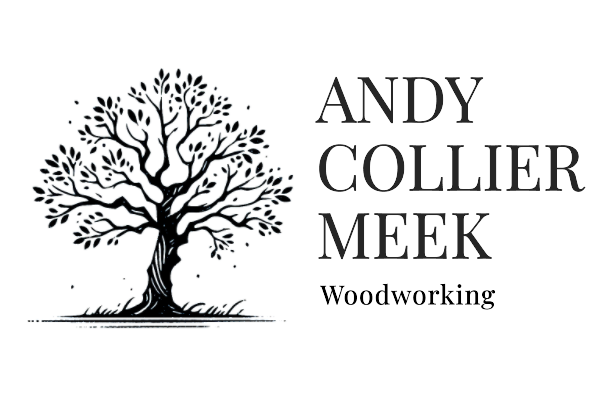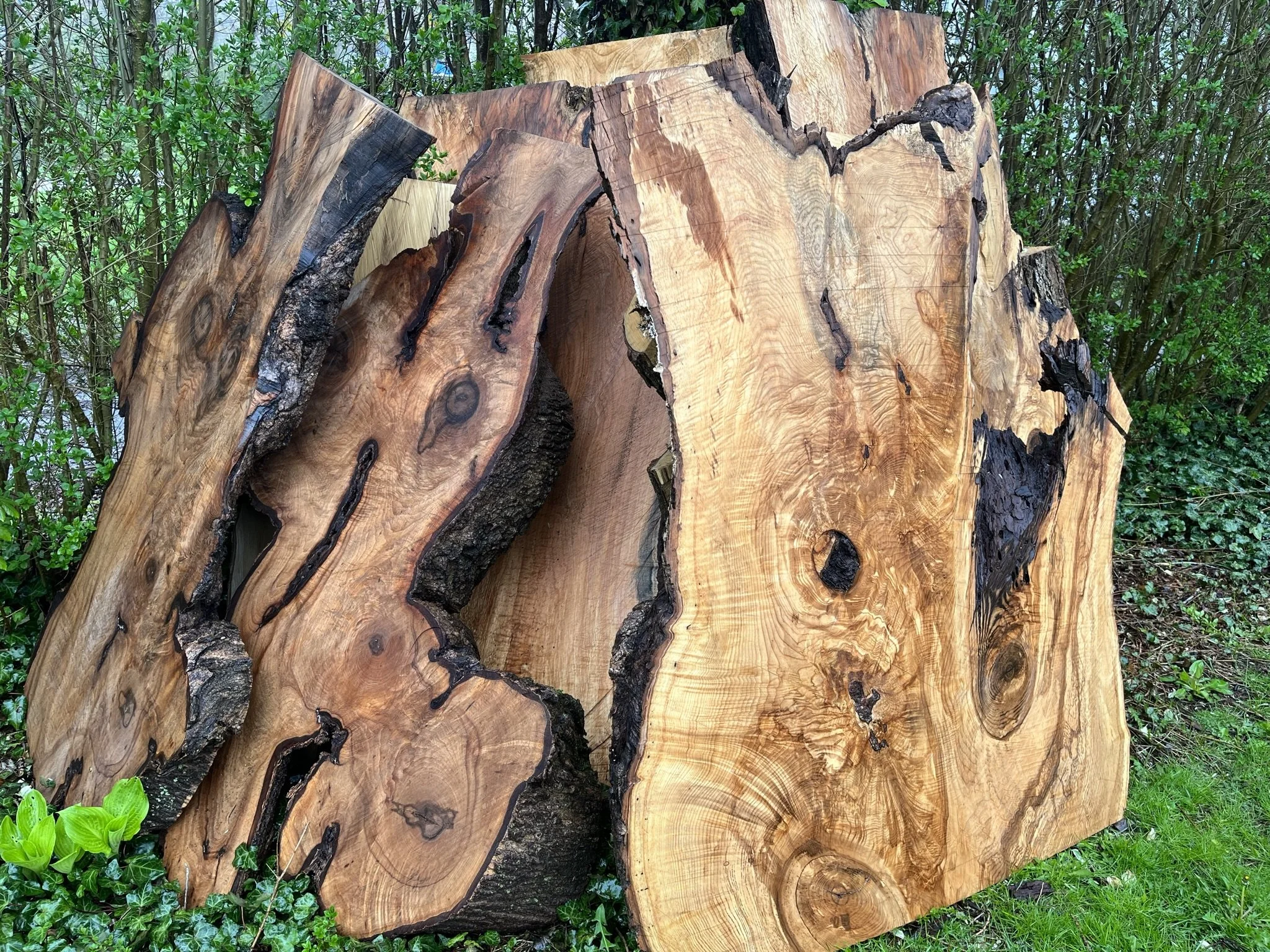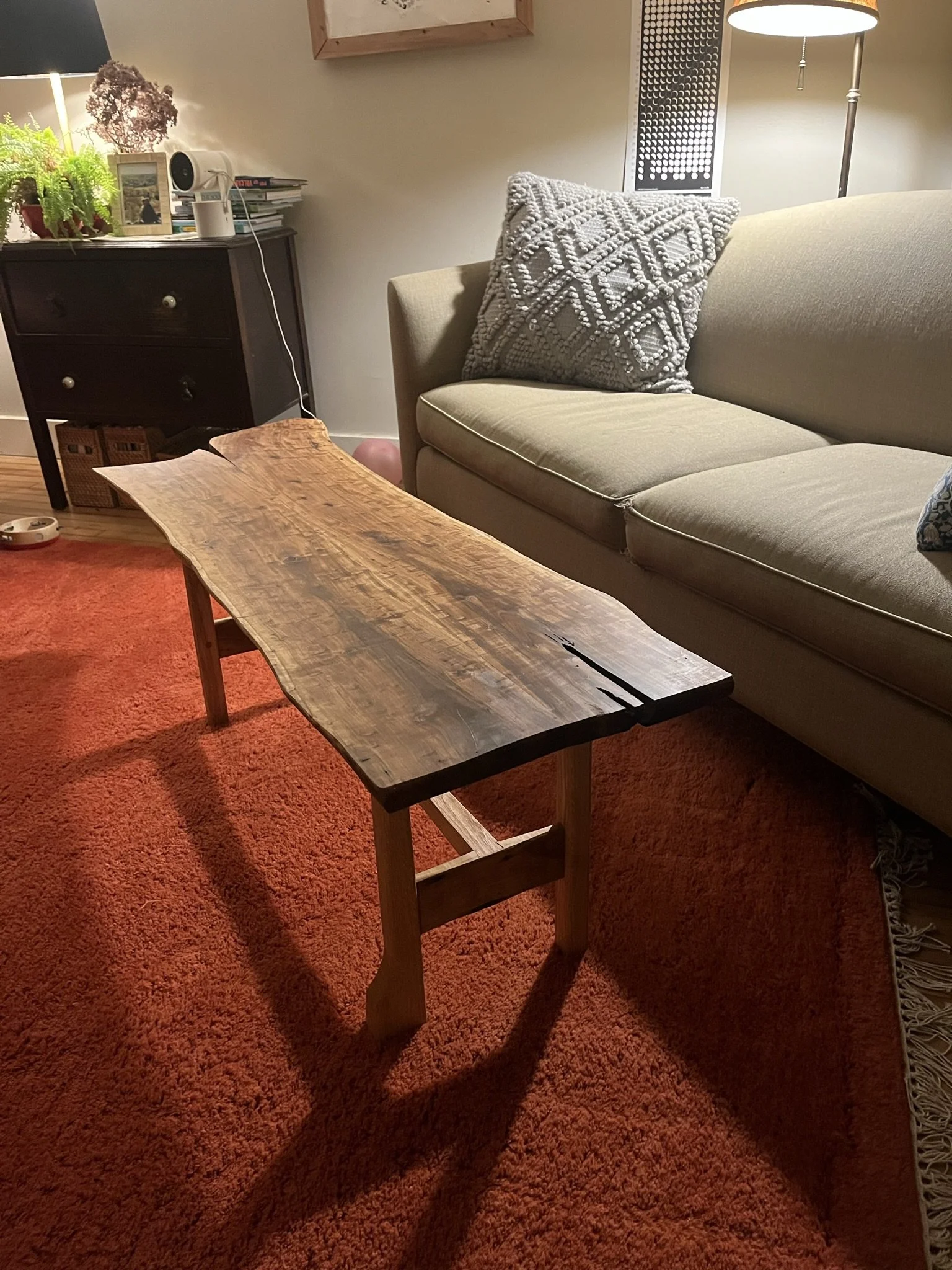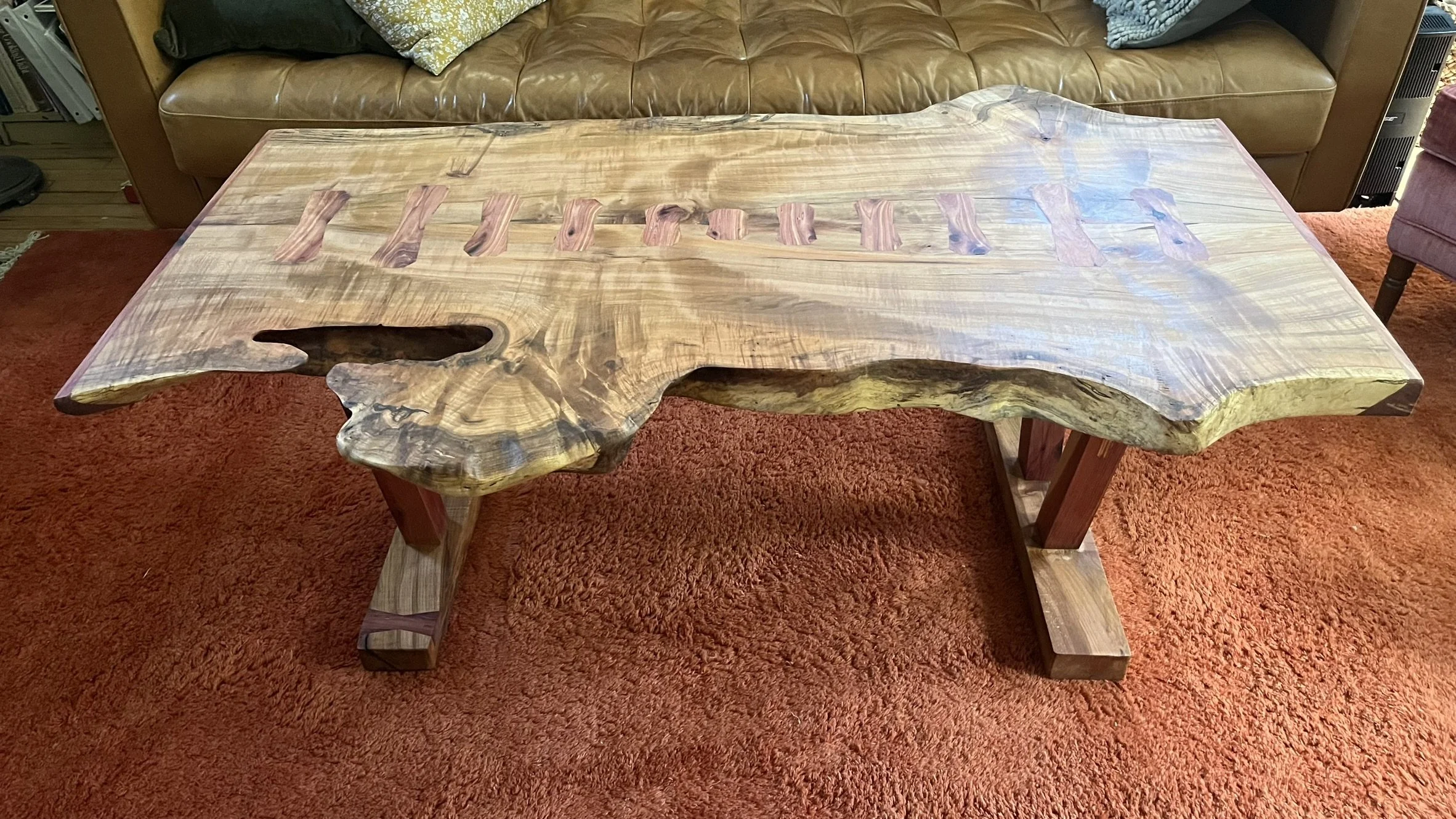-

Ash and Maple Chaise Lounge
Chaise lounge is just the closest label I could come up with for this piece. There’s little concern for norms in the design, the priority was always to showcase this incredible sugar maple I found on the side of the road in North Stonington. Mounted at a slight angle on its two legs, tenons of ash pierce through the slab following the naturally curved path of the branching grains to form a seat. The result is a treasure of nature, inviting you to come snuggle up and get cozy with a book.
This piece is available, inquire for price.
-

crotchety red oak bench
The workflow of a project is one of constant revision and improvisation. I don’t do much in the way of drawings before starting a project, sometimes a basic sketch of proportions, but overly detailed planning is often futile when working with hand tools on such non-standard pieces of wood. Here I have a goal of attaching the legs with a combination of sliding dovetails and mortises, and it’s time to see how plans overlap with reality now that the legs are roughly assembled and ready to be joined to the bench top.
-

The Live Face door
I knew that this slab, the outer edge of an old pignut hickory that fell in a storm, deserved a featured place in a project. It became the front panel of a drybar, which can open outward on its wooden hinges. Comes with a kickstand for extra support for the door during extended periods of openness. Thick, quartersawn ash panels frame out the cabinet and legs with a quiet dignity that pairs well with the primal hickory.
This piece is available, inquire for price.
-

Cross section of Ash
Getting a flat crosscut of this tree was a wild ride. It started nearly 6” thick and after a year outside I resawed it to flatten the faces. The now 3” thick slice of the tree was rolled into the studio, where it proceeded to curl up like a pepperoni on a frying pan, and required flipping multiple times per day at first to keep it from curling too much in one direction. Cracks were monitored and stopped with butterfly patches if they threatened to crack the piece in half. Finally, when it was fully settled months later, I planed it to its final thickness of 2” and added several more butterflies to lock things in place. To keep it rock solid, I built a walnut backing brace/frame, which the ash is held to by dowel and epoxy.
-

Sugar Maple Bench
The incredible figured grain and hint of live edge on this bench made of 150 year old sugar maple are luscious and decadent. The form is simple and inviting. The kids clamber up and on it like animals and it doesn’t wiggle or shake. This was the first piece I built where I achieved the goal of using no glue at all. Just joinery, nothing to wear out and loosen up. A very important feature for furniture mainly used by kids. I look forward to this bench passing down through the generations and withstanding many more childhoods.
-
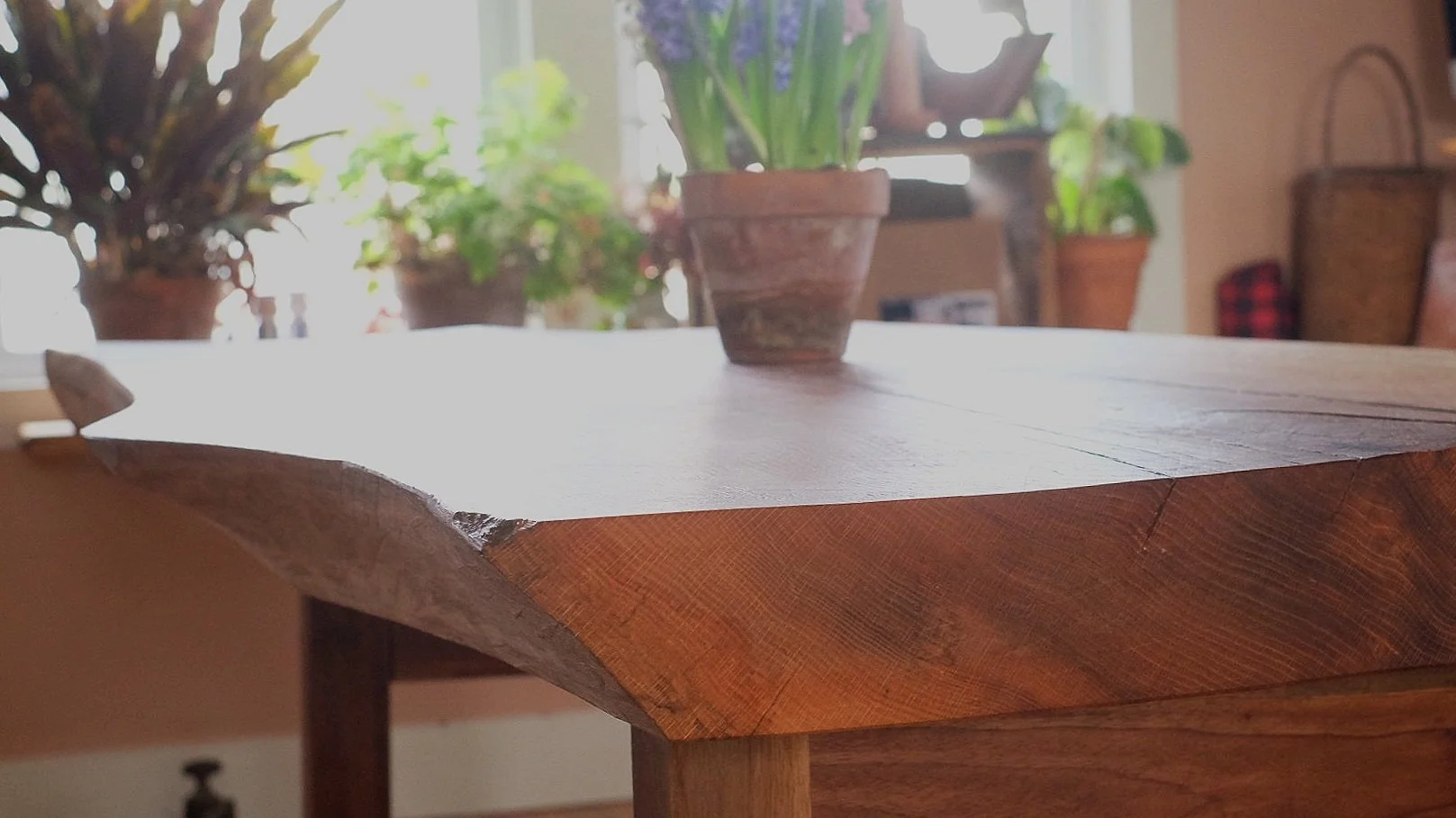
Thick Thick Table
One of my first projects when I started collecting larger slabs was to replace our rickety old dining table. At the time, I was still very new to sawing such large trees with the chainsaw, and the cut faces were not very square with one another. I was doing all of my planing by hand, putting in my 10,000 hours learning how to use the old hand planes, and it took me a week to get just one face smoothed, at which point i decided to let the bottom stay rough sawn. When I brought it inside, it was still green. It’s surface warped and cracked a bit, with the smooth top face becoming wavy and swollen in places as the wood dried but remaining silky smooth to the touch. Thanks to the thickness of the slab at 5+ inches, it weathered the rapid drying without any structural warping, leaving us with a delightfully natural and rock solid table. I’ve learned a lot since this build, but it’s still one of my favorites for the warmth of spirit it holds.
-
Fresh cut maple and ash slabs
A trick to get a preview of what a rough cut slab will look like when it’s been finished is to get it wet. Fortunately for me, it means I have an art gallery in the backyard every time it rains. These pieces all come from trees over 150 years old. The rippled and compressed figure of their grain tells the story of massive forces shifting over that time.
-
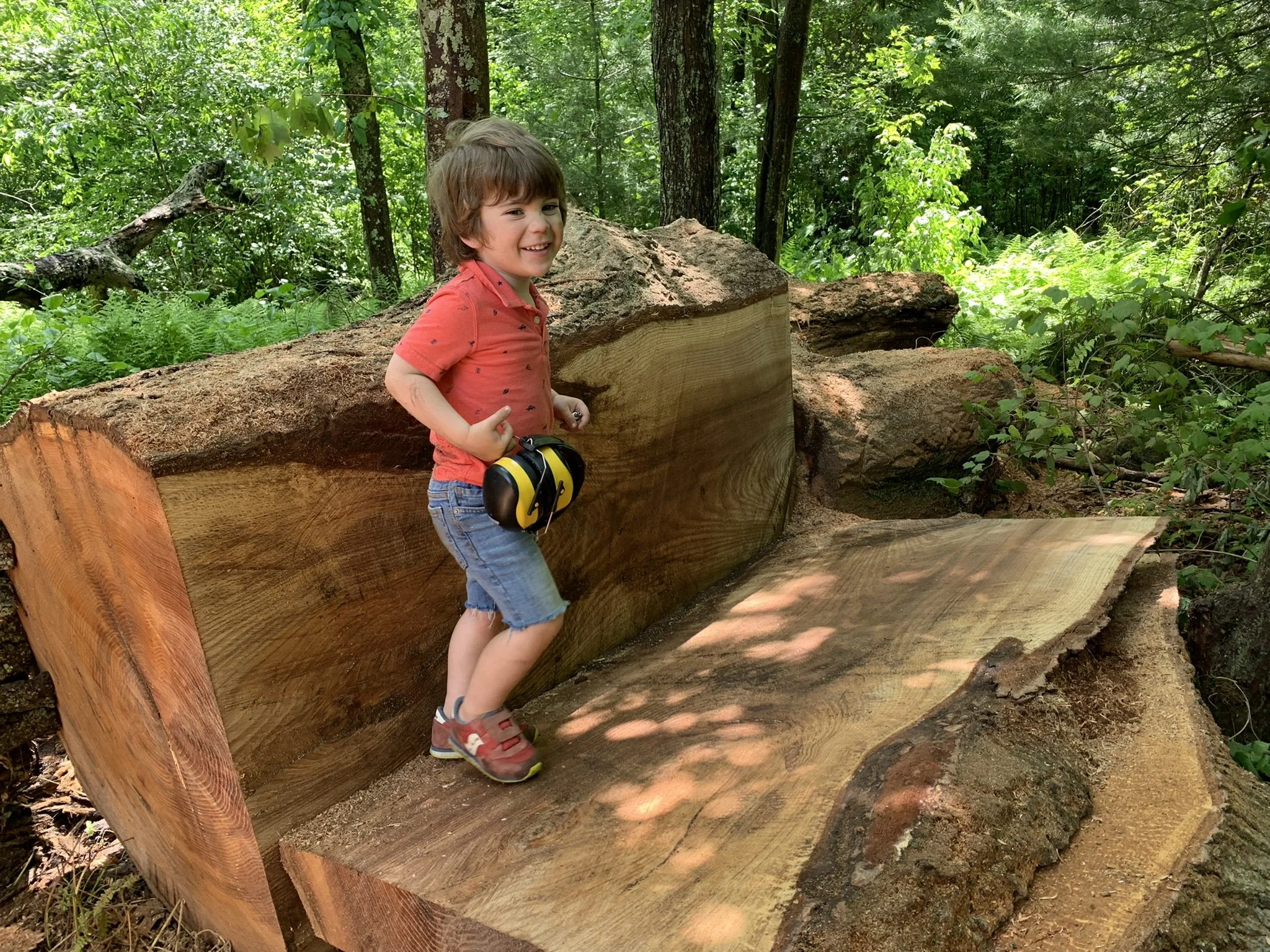
Milling together
Henry and I will jump in the truck and head out to saw a slab or two from a log before it’s time for his preschool. “Did you remember my headphones, Papa?”
-

Morning in the shop
It’s really simple. You can see nearly all the tools I use in this one shot. I love that I can easily move my setup around, and how a small variety of hand tools can open the door to such immense creative possibilities and freedom. It doesn’t hurt that none of them need a dust collector.
-

Floating Hollow Ash
This set of floating, wall mounted shelves were made with some hollow rounds of ash from a friend’s house. The interiors and portions of the exterior not squared off were smoothed using a yari-kanna, which is a fantastic and ancient type of planing tool that allows a silky smooth finish on an uneven surface.
-
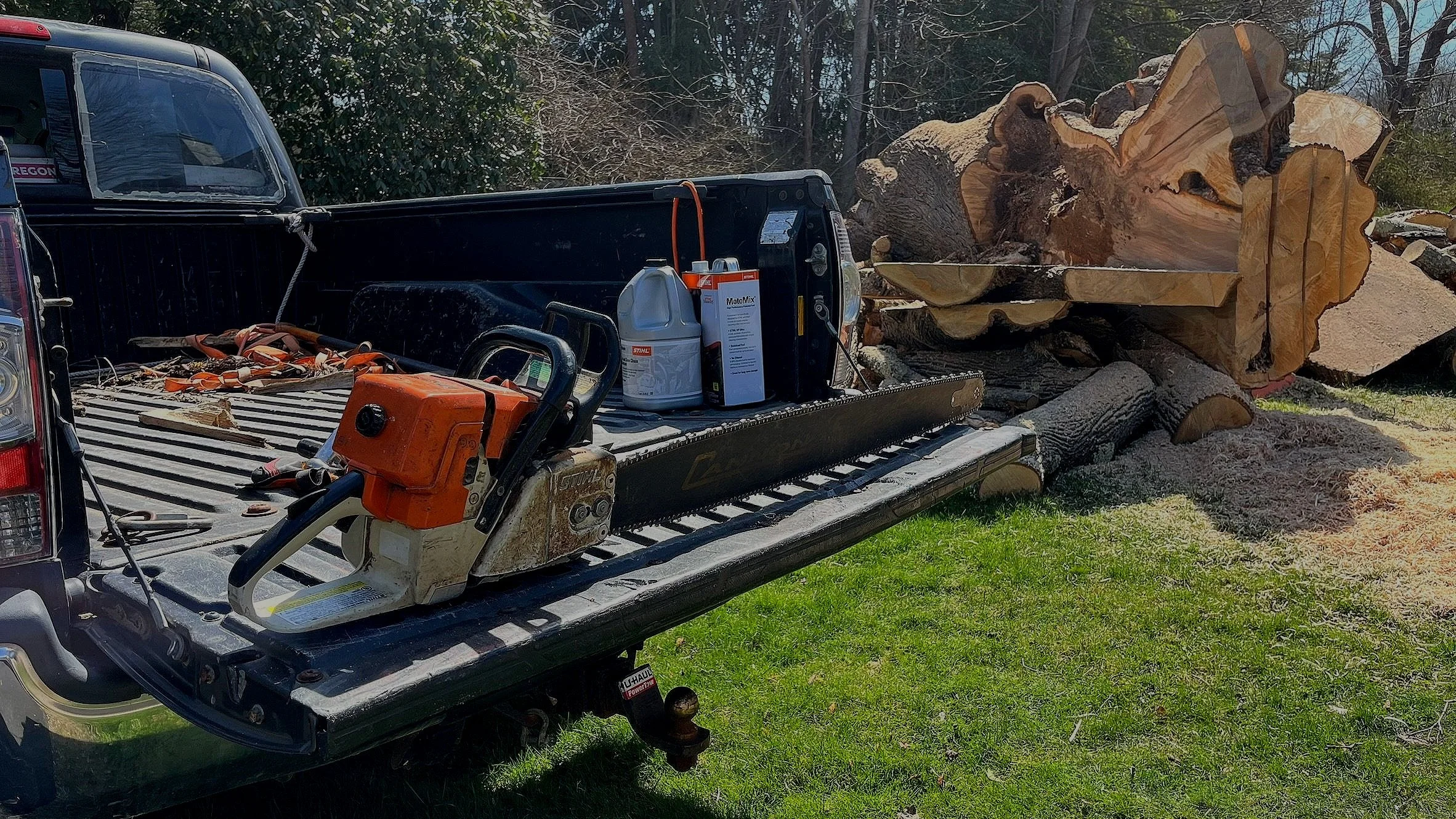
A truly portable sawmill
I’ve gotten a lot done with this old saw. After leaving my career in farming, I taught myself to mill freehand with it. I use a 42” bar on a Stihl 440, and that’s about as scrappy as you can get. But the best saw for the job is the one you have. What’s more portable than a handheld sawmill that requires no accessories at all?
-
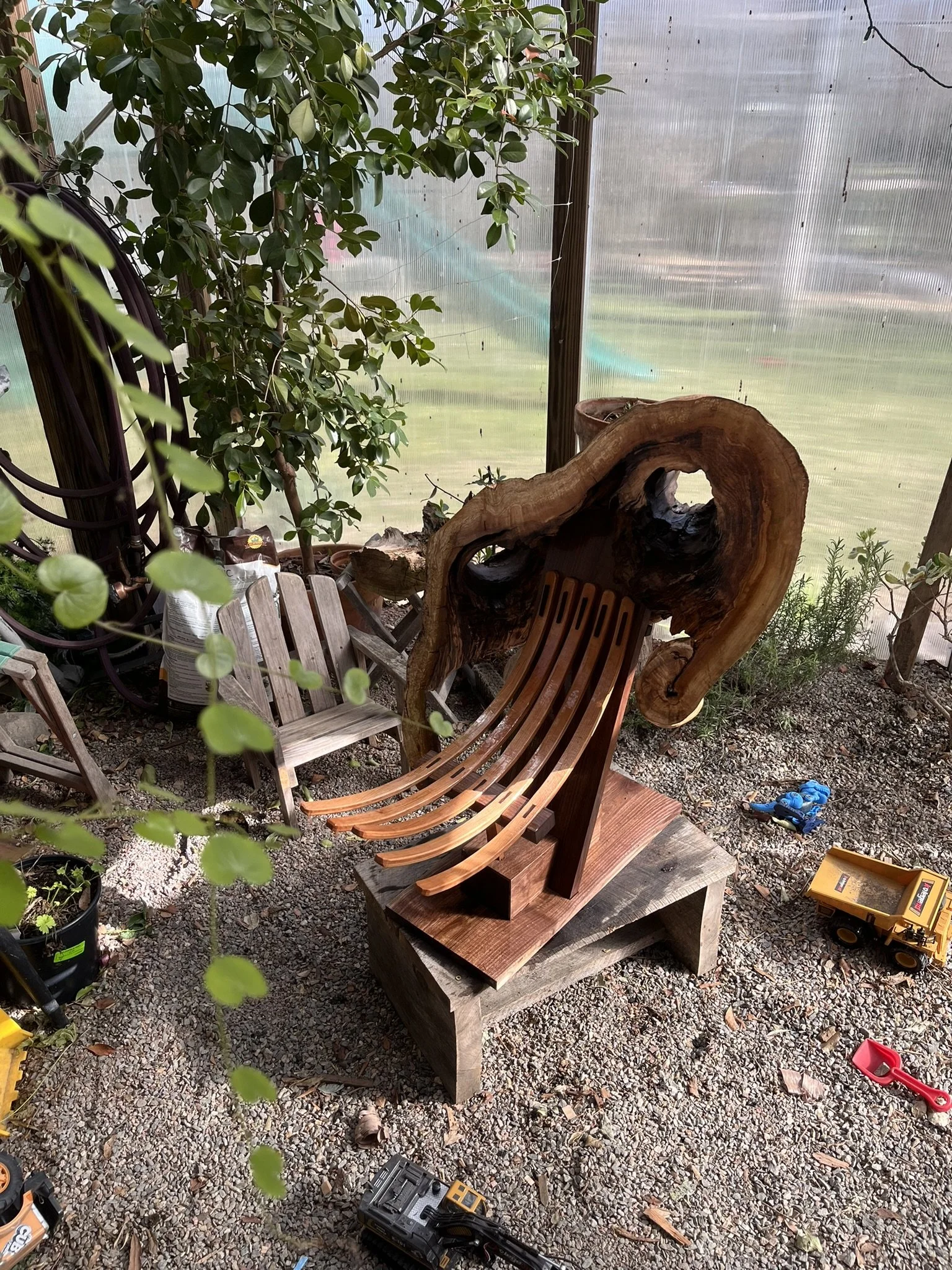
The Detox Chair
The oil is still wet on this admittedly bizarre piece. The challenge of detox led me to tackle crafting something unique with this double-hollowed chunk off the side of a 160 year old ash tree. A geometric and simple walnut pedestal base contrasts with the wild “headrest”. Simple laminate-curved slats of cherry are held in place with small wedged tenons.
I’m very excited to say that this chair won an award at the Artists Cooperative Gallery of Westerly in their 2024 Regional Juried Exhibition.
This piece is available, inquire for price.
-
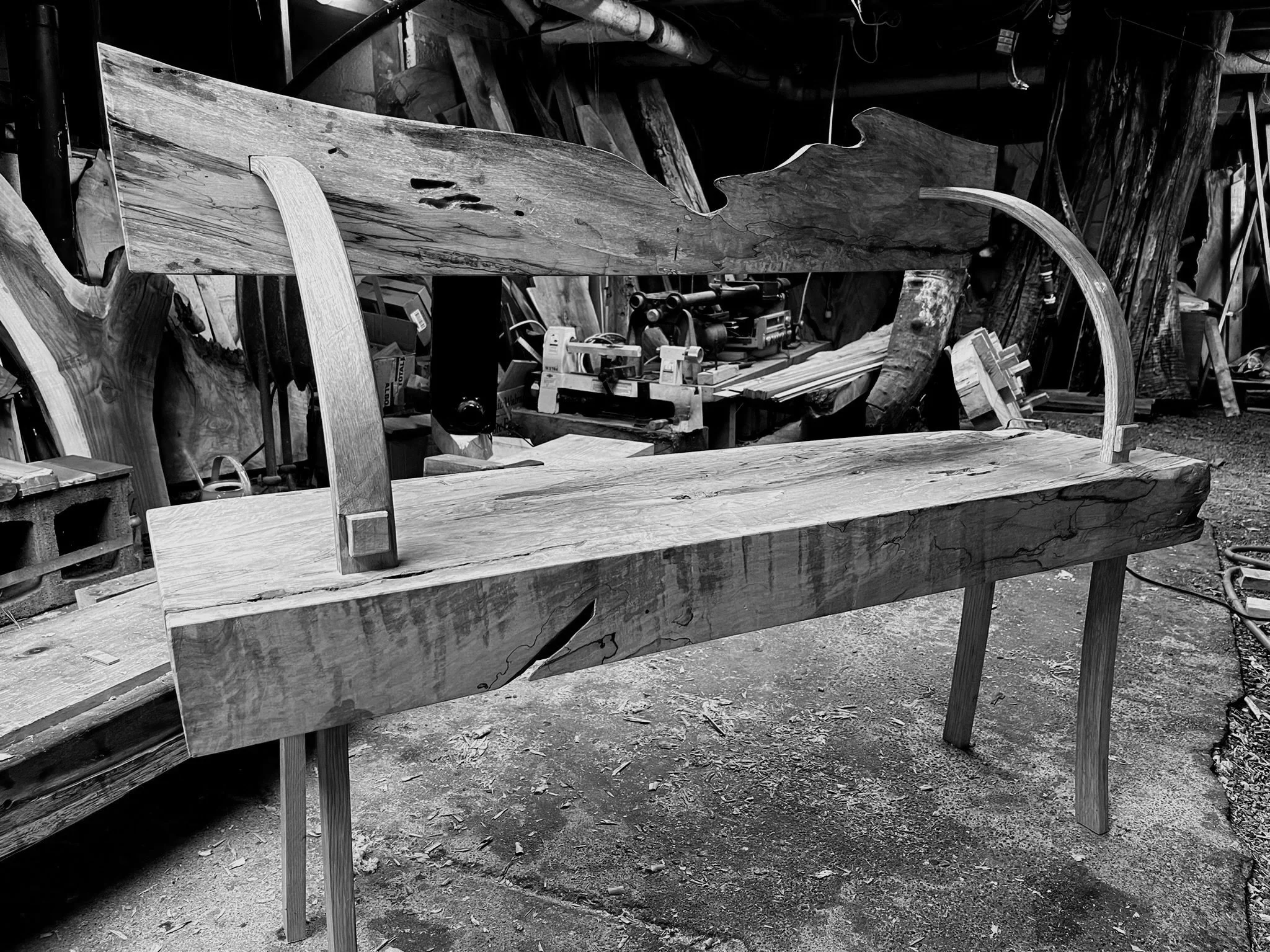
Spalted maple and laminated oak bench
This bench was just about done at the time of this picture. I find laminations to be nostalgic, as making ribs for a sailboat frame with the same technique was what got me back into woodworking in the first place. It’s one of the few times I don’t mind using some glue for a project. This beautiful maple slab seat, with its book-matched, floating back, also made me bend rules and I used penetrating epoxy to harden it a bit... spalted (fungally colonized) wood is extraordinary looking, but it’s a whisker away from rotten. Seemed worth a little epoxy to preserve.
-
Applewood bench/table
It’s a sad thing to see an apple tree bite it, but applewood is one of my favorites to work with. Silky and fine grained, it practically glows with a caramel warmth. It carries a memory of being a tree with seasonal fluctuations of stress (apples weigh a lot on the branches); It’s one of the most lively woods, liable to shift and warp like a rapscallion when being re-sawn or worked.
-

Alai'a
I thought I might learn how to surf, so I made a traditional Hawaiian surfboard, an alai’a. It’s just thin plank of ash, with a slight concave hollow in the bottom. At a quarter inch thick, it was the thinnest I’ve milled with a chainsaw so far. Shaping was fun too, but I still don’t know how to surf :( If you do and you want to test this for me, get in touch!
-

Iron stained maple table
That blue hue to the wood of this table’s top is no finishing technique. The coloring comes from the tree’s reaction to prolonged contact with iron, in this case it was a tap for maple syrup that had been left in the tree 80 years ago, and long since been completely engulfed, creating a large patch of blue wood within the sugar maple. It was a disappointment to discover that tap with my chainsaw at the time, but the pain of a lost chain is forgotten and the beauty of the wood remains.
-
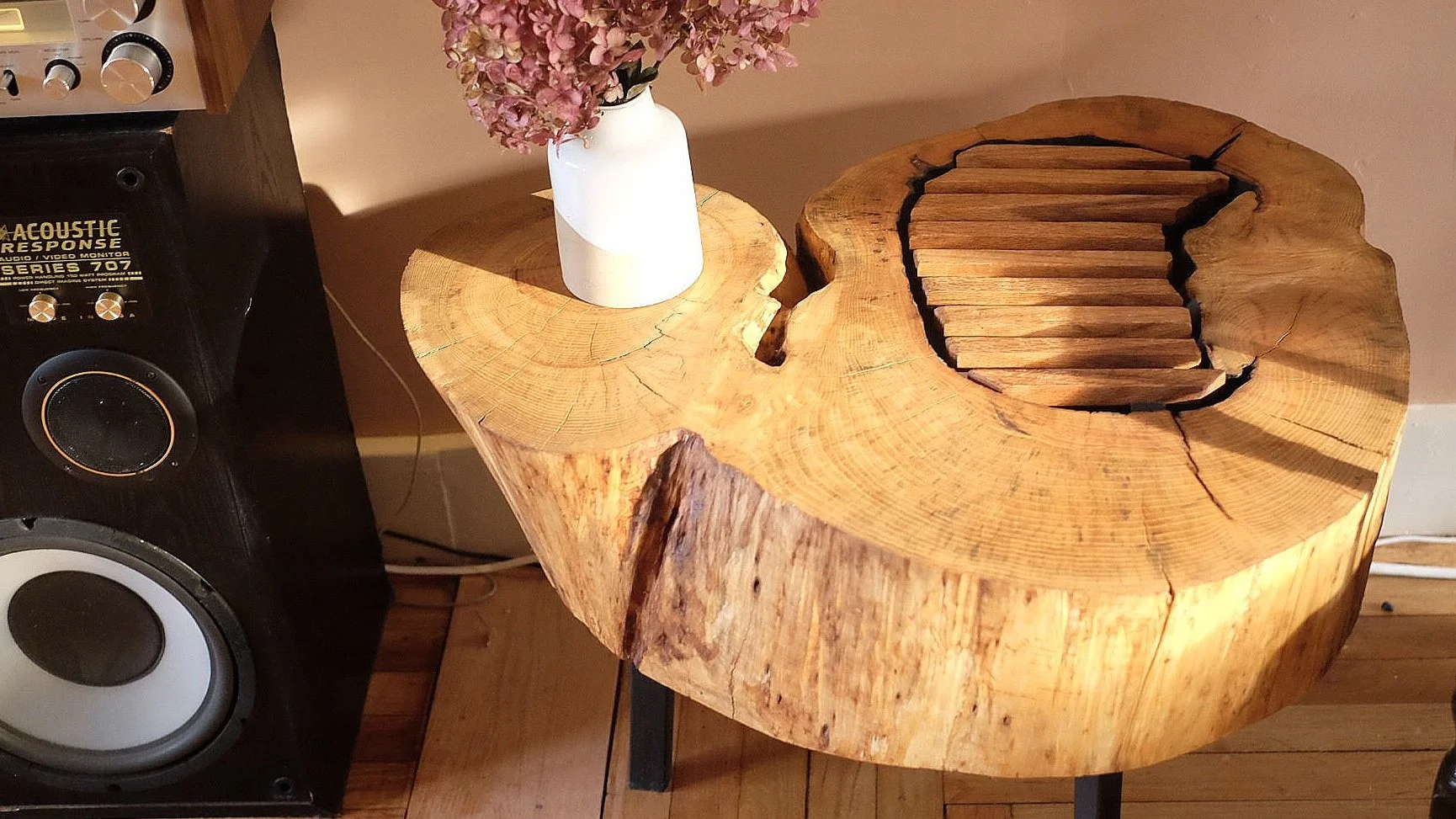
Hollow ash table with set-in
The table is lovely, and the grill of ashwood that covers the hollow can be removed… if for some reason you need to stick something through your table. An umbrella? The thing I like best about it is that due to the heft of the table top, and the delicacy of the laminated legs that are mortised two inches into the bottom, if you give the side of the table a slap, it jiggles a bit like jello in the most satisfying way. Hard to capture in a photo.
-
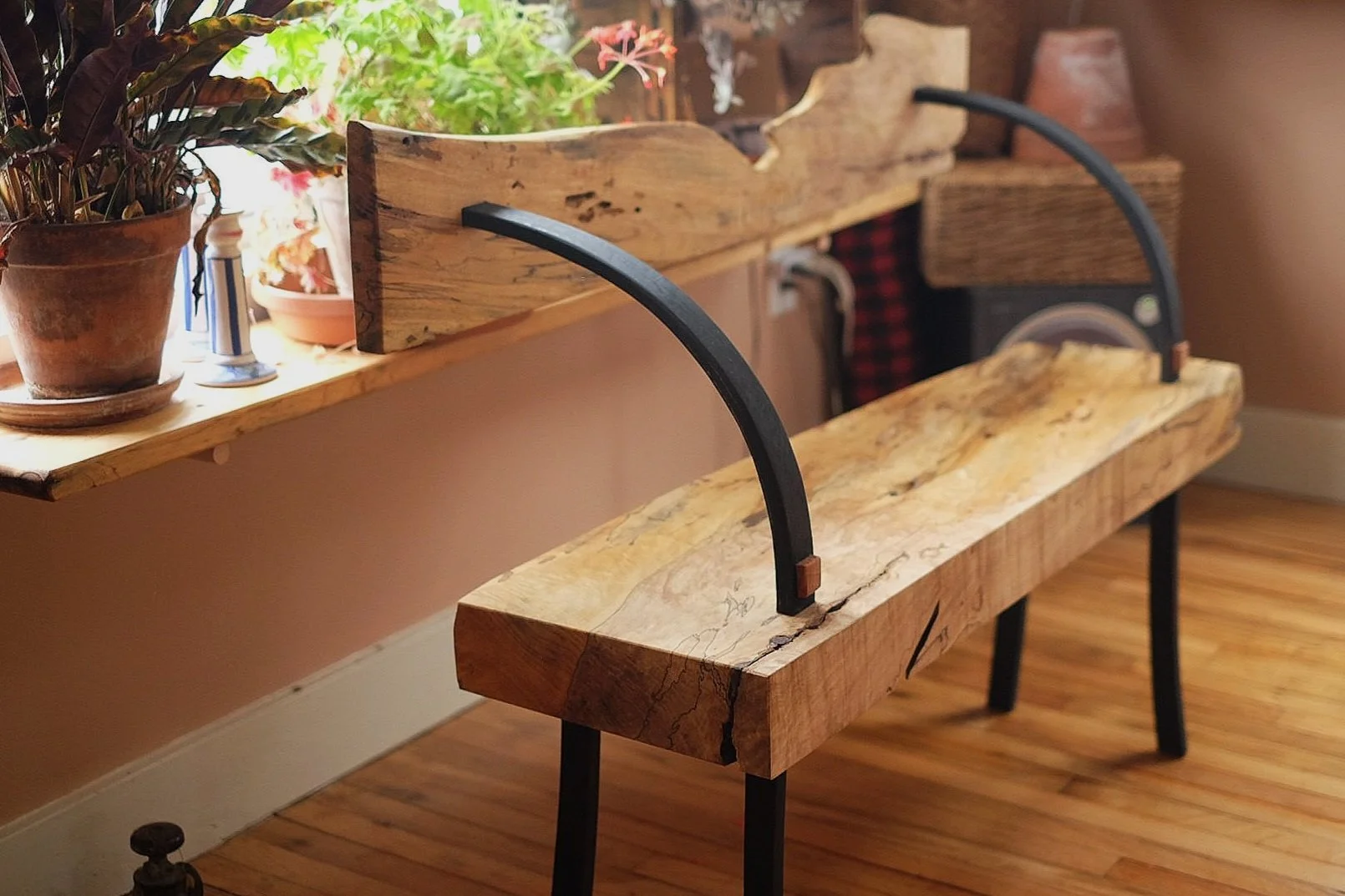
Spalted maple and laminated oak bench
Using some black milk paint on the legs and arms of this bench really makes the black spalting lines pop from the maple slab. It almost looks like somebody has incorporated fine ink-work into the grain of the wood. The springiness of the back is a real delight when you throw an arm over it to relax. A very modern design that feels surprisingly comfortable and inviting.
This piece is available, inquire for price.
-

Black Hemlock Bench
A quick solution to a bench shortage. A two and a half inch thick plank cut from some fallen hemlock, with the ends sawed off and turned into legs. Chunky through-tenons showing through the top of the seat give this bench and instant rustic comfort. It also doubles as a great little desk for my wife when she feels like working from a couch.
-
Maple and Cedar Coffee Table
A classic book-matched table, made by sawing a thick slab in half and then “opening it up” like a book. The kaleidoscopic reds, pinks and yellows of the Eastern Red Cedar bowties, legs and end caps brings out the caramel warmth of the highly figured Sugar Maple top and feet. I had to make a leap of faith on the colors; prior to oiling, the cedar is flourescent pink and was quite jarring against the blondish raw maple. Finished with tung oil, harmony emerged.
